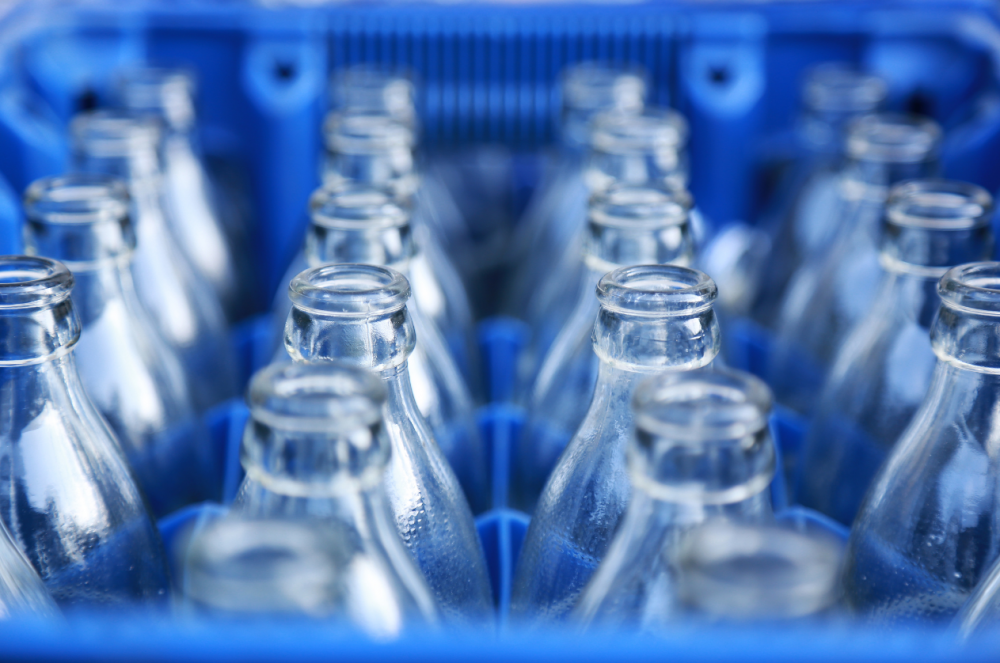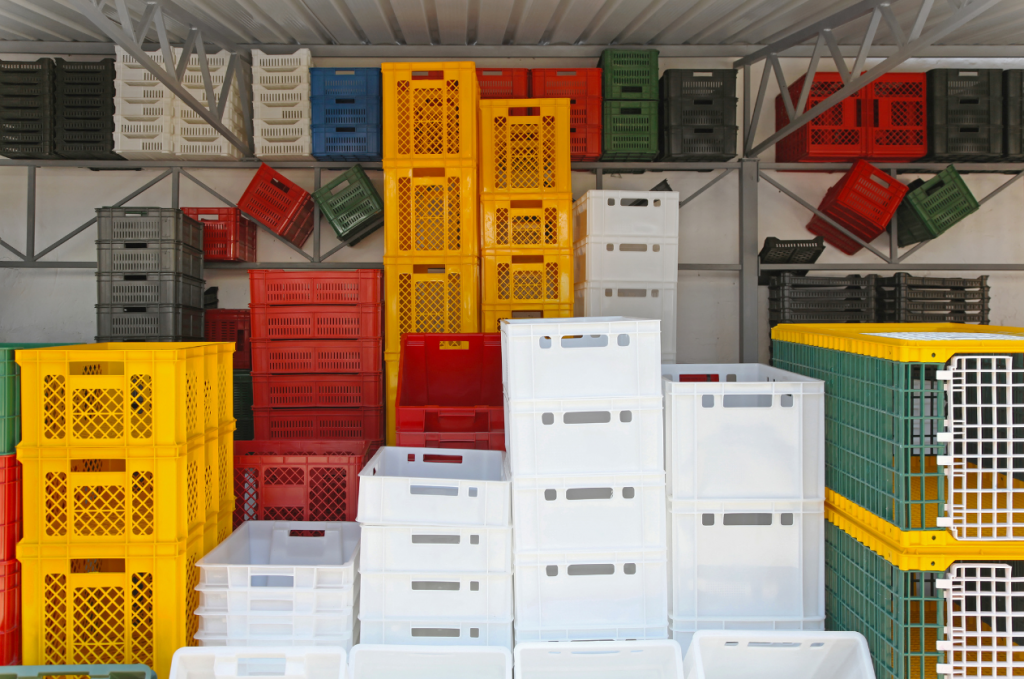Why is sustainable secondary packaging important?
Sustainable secondary packaging is used to protect primary packaging and to transport goods all around the world. As a solution that is used by every industry, it is crucial for manufacturers to consider sustainable packaging solutions to meet their environmental commitments and global sustainable development goals (SDGs). By using post-consumer materials that can be recycled or reused, manufacturers can significantly reduce the amount of waste produced each year and help preserve our environment.
The environmental impact of secondary packaging
10 billion pallets are in circulation around the world. It’s no secret that secondary packaging has a huge environmental impact. From the production of materials to the disposal of waste, packaging leaves a heavy footprint on our planet. We have all seen cardboard boxes thrown in the street or in supermarkets every morning. Landfills are filled up with wooden shipping pallets that are used once and discarded, and the list goes on.
The good news is that the positive impact sustainable secondary packaging has the potential to be as big as the industry itself. Businesses are starting to implement packaging solutions with recycled and recyclable materials. Packaging solutions are being made with more sustainable materials that come from renewable resources, such as bioplastics or waste-based plastics. Sustainability is also addressed by manufacturing secondary packaging solutions that are durable and can be reused over and over again.
Secondary packaging and post-consumer materials
Post-consumer materials are finished products that have already been used and were sent for disposal or recovery. Using these recovered materials as feedstock instead of virgin raw materials made from natural resources helps reduce pollution, conserve finite resources, and save energy. By unlocking the value of waste and recovering post-consumer materials, manufacturers can help reduce the carbon footprint in their supply chain and contribute to combating climate change. Moreover, upcycling helps to improve waste management practices and conserves natural resources for future generations.
Post-consumer materials can be reused in many ways. From recycling aluminum cans and paper to using unsorted waste to produce bio-based plastics – these methods help conserve energy, prevent deforestation, protect the environment and improve waste management practices while improving the health of local communities.
Secondary packaging is a method that is used globally and by every industry, playing a key role in saving our planet. Packaging solutions such as crates and shipping pallets are generally made out of wood or virgin plastics. Substituting these materials with upcycled materials could significantly reduce the environmental footprint across supply chains in different industries.
By substituting wood, plastics, and other materials made from finite resources, industries are able to tackle the waste problem at its source. Using post-consumer materials instead of new materials made from trees or petroleum reduces the amount of waste and emissions generated. Moreover, recyling processes require less water and energy than general processes for manufacturing new materials. By reusing materials, we can help to make a positive impact on the environment and drive a systemic shift in society to get closer to a truly circular economy.
In a world where an ever-growing population is increasingly reliant on single-use and disposable packaging, it’s more important than ever to choose sustainable packaging materials. In the materials space, biobased thermoplastics are becoming more popular when searching for a more sustainable alternative. In the long run, sustainable packaging offers economically viable solutions that are both good for business and good for the planet.
Companies continue looking for ways to enhance sustainability in packaging with design, technology and innovative materials such as UBQ™, a biobased thermoplastic made from 100% unsorted household waste. UBQ™ is already being used by leading brands such as PepsiCo and ABinBev in their secondary packaging. By substituting oil-based resins and wood with UBQ™ in their crates and shipping pallets, they are able to reduce the carbon footprint and get closer to their corporate sustainability goals.
By using UBQ™, manufacturers are diverting waste from landfills, preventing methane-related emissions and supporting the circular economy that protects finite natural resources.
Packaging design for sustainability
In recent years, there has been a growing emphasis on sustainability in all aspects of life, including design. The choices we make about the materials we use and how we dispose of them can have a significant impact on the environment. When it comes to packaging, one of the most important considerations is a smart design to reduce wasted scraps and enhance durability, recycled content and ensure its recyclability.
Unfortunately, many common packaging materials are not made from recycled materials nor are they recyclable. For example, most types of plastics can only be recycled a few times before they need to be disposed of in a landfill. This means that the recycling symbol on a pack does not always mean that it can be placed in your weekly recycling collection.
In order to increase the amount of recycled content used in the products we use, we must look at the source of the feedstock. For example, using bio-based materials (such as UBQ™) is more sustainable than using fossil-fuel-based materials (such as polypropylene). When it comes to sustainable packaging design, there are many factors to consider. As consumers, we can demand better manufacturing and make more informed choices that will help to protect our environment.
Reducing waste and achieving a circular economy
Whilst some waste can be recycled or composted, much of it still ends up in landfills, where it can take hundreds or even thousands of years to break down. Today, only 13% of all municipal solid waste is recycled. With the world’s population continuing to grow, the problem of waste disposal is only getting worse.
The amount of waste we produce can be reduced in different ways. Consumers can look for products made with recycled content, send goods to recycling after use or even try to reduce consumption by repairing what they already have. Manufacturers, however, play a crucial role. Even though they cannot control the entire waste production, they do have the power to tackle the problem at its source by choosing post-consumer materials as feedstock. As individuals, we can make small changes in our daily lives, but when we work toward this goal together, both manufacturers and consumers can set a higher standard and help achieve a circular economy where waste is no longer wasted.
Achieving a circular economy is essential for the sustainable development of our planet. It aims to keep materials and resources in use for as long as possible, and then recycling them back into the economy when they are no longer needed. This closed-loop system is in contrast to the traditional linear economy, which relies on a linear supply chain of raw materials being turned into products that are used and then thrown away.
Innovations in sustainable packaging
As the economy continues to grow so does the demand for packaged goods. It is evident that the packaging industry has a major impact on the environment, contributing to pollution and waste.
There are a number of innovative packaging materials and methods that can help to reduce the negative impact on the environment. In addition to suggested post-consumer materials and smart design mentioned previously in the article, 3D printing is an innovative method that supports more sustainable production. 3D printing saves material, power, money and time while preventing wasted scraps.
The future of sustainable secondary packaging
Secondary packaging is an essential part of the modern world, helping advance global economy by transporting goods in a safe and effective way. However, the secondary packaging industry, like many others, faces challenges in the need to reduce its environmental impact. There is a growing push for sustainable packaging solutions and businesses are starting to make the shift to greater sustainability.
Secondary packaging solutions made from upcycled materials such as UBQ™ are also durable, making the product reusable unlike products made from wood that can easily break. Reusable packaging made from post-consumer materials dramatically reduces the amount of waste that ends up in landfills.
Substituting wood and oil-based plastics with materials made from waste is possible. UBQ™ is an existing and scalable solution that is already being implemented in various industries, including in secondary packaging. By using waste as a valuable material, industries are also reducing the amount of waste that is produced in the first place.


